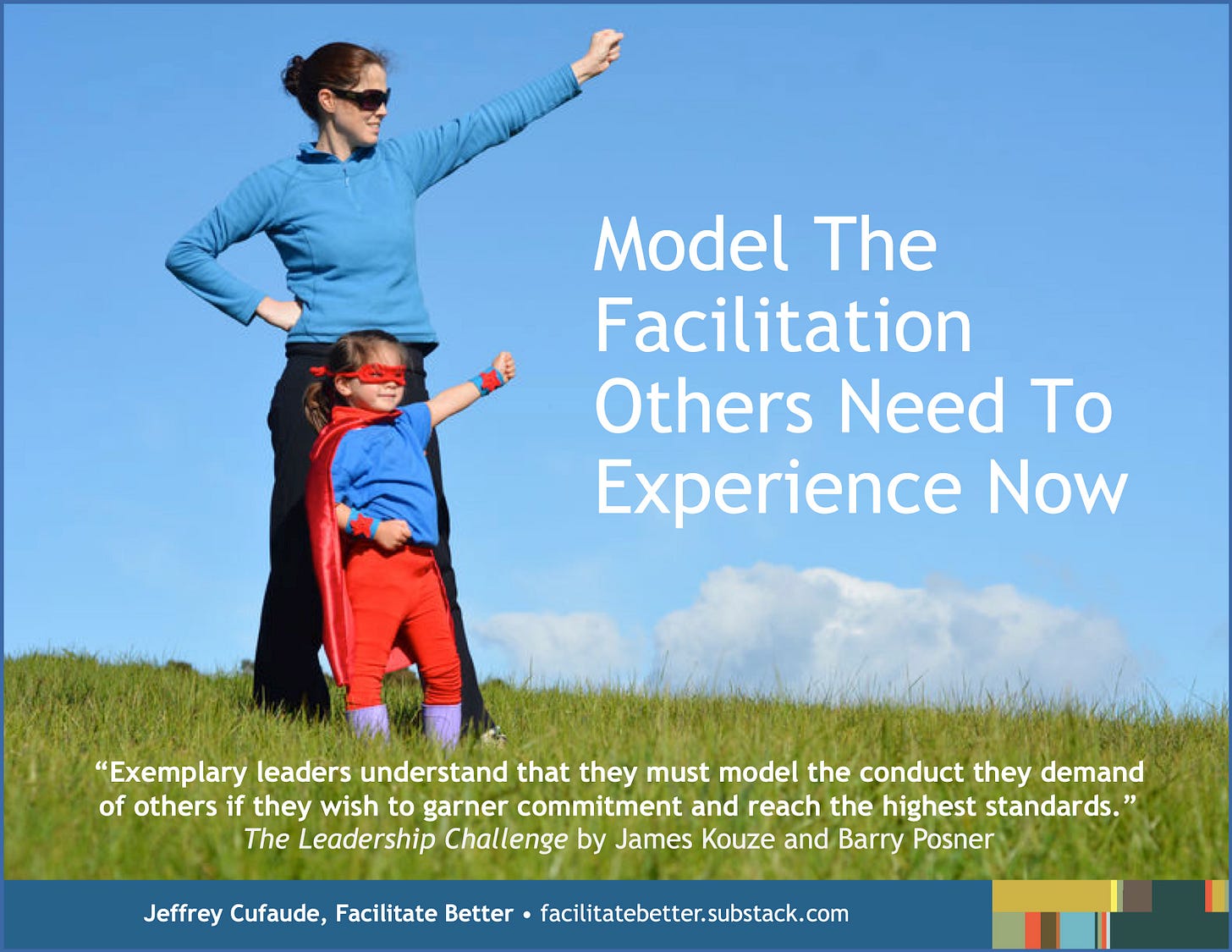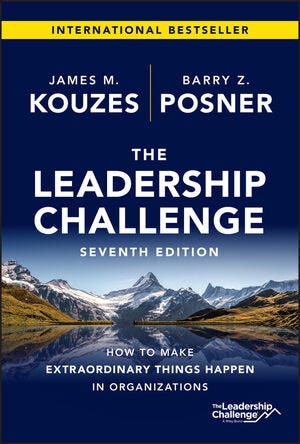Model the Facilitation Others Need to Experience Now (Facilitation Friday #52)
If everyone followed the facilitation example you set, would their performance—and the results of their organizations—improve?
If everyone followed the example you set as a leader, would their performance—and the results of their organizations—improve?
A mentor posed this question to me early in my career as a university student affairs professional advising student leaders and their organizations.
I recall nodding earnestly at the relevance of his question while also feeling somewhat terrified at its implications for my efforts. I was just one guy, fresh out of grad school, brimming with ideas but lacking in experience.
Eventually my misguided interpretation that I needed to be perfect in everything I did evolved to: bringing great care and intention to my work, the choices I made, and the example I provided.
I still do so today. I often think of my mentor’s counsel when I prepare to design and facilitate a workshop, meeting, or conference.
What example will my efforts set for others?
What do I hope they might learn or infer from what I do and how I do it?
How can I generally ensure my actions, both in preparation and in real-time, are aligned with my values and intentions?
In what situations—or with what types of participants—am I most likely to drop out of alignment with the values and intentions I most want associated with my work? Why might this be the case and how can I prevent it?
When might I most likely slip into autopilot mode and risk my efforts being perceived as generic or inauthentic?
We all provide an example.
Regardless of how we feel about it, we are all role models. Every time we engage in the act of facilitation, others may draw lessons about effective (or ineffective) facilitation from our efforts.
I know I cringe a bit when I experience a facilitator misusing (in my opinion, of course) an icebreaker activity, a facilitation tool or technique, or a critical model or concept. Here’s a simple example:
A facilitator uses a “parking lot” to park off-topic ideas or issues that arise during a meeting, but then fails to have the group review and address them, essentially permanently parking them into oblivion. The next time those participants see a facilitator use a parking lot, they may recall this previous experience and potentially infer the same outcome will result.
On some level, all facilitators’ efforts are loosely interconnected. Participants develop expectations, both good and bad, based on meetings and workshops they’ve attended. They carry them into subsequent gatherings. I don’t want my facilitation efforts to set up someone else for a challenging facilitation experience because I failed to do a good job.
Modeling the way
In their seminal research and book The Leadership Challenge, leadership scholars James M. Kouzes and Barry Z. Posner identified Modeling the Way as one of the five practices of extraordinary leadership.
Corresponding to this practice are two specific commitments:
“Clarify values by finding your voice and affirming shared values; and
“Set the example by aligning actions with shared values.”
Have you done this for your facilitation efforts?
Whether doing this for the first time or as a refresh for the year ahead, think about the type of facilitator you want to be. Identify 4-6 core values and/or qualities you want others to associate with your facilitation and that you will draw on to inform all of your facilitation choices. Note them in this worksheet:
While what you observe in others’ facilitation efforts might inspire your choices, make sure your selections reflect your voice and that you can apply them authentically. Don’t simply mimic what you see in others.
For each value or quality you select, brainstorm and note on the worksheet how to align your facilitation efforts with it in common meeting or workshop segments. Let’s say one of your choices is community. How will community be present in:
your communications to meeting or workshop participants?
the room set or online platform and how people are welcomed to it?
what you do as people arrive and how you formally open the session?
any icebreaker or priming activity you use to initially connect participants to each other?
when breaks and meals are scheduled and how the space for them is set?
any closing reflection and/or application exercise?
Initially, you may find it helpful to “proof” each element of your meeting or workshop designs for how well they align with your intended values or qualities. Over time, with sustained attention, the aligned actions you tend to take will simply become defaults for “how you do what you do.”
However, when you facilitate a new type of gathering, you may want to return to your values and qualities and consider how they can inform this new experience you will help lead. New experiences often require new choices or behaviors. In addition, we should always seek new ways to exemplify our intentions and values in our facilitation efforts.
Alignment requires self-evaluation and feedback.
At year’s end I do an annual audit, a self-evaluation reflecting on my values and qualities and considering possible refinements for my future efforts. To inform this audit and to receive ongoing feedback about how well I model the way with my facilitation—how well my actions align with my intended facilitation values and qualities—I turn to participant evaluations and one simple question I always include:
What are three adjectives you would use to describe the session led by Jeffrey Cufaude?
I tally the responses religiously and compare them against the core values and attributes I hope people associate with my work. For many years now, these have been the five most common adjectives (not in any particular order) others associate with my efforts:
thought-provoking
engaging
intentional/purposeful
useful/practical/applicable
enjoyable
Happily these align with my own intentions. For a few of my efforts though, the percentage of responses for one or more values fell a bit short of my ideal. That lets me know I need to identify what more I can do to bring integrity to that specific value or quality in comparable sessions in the future.
Bottom Line
Every time we facilitate, we model the way for others. If people only learn about facilitation or how to facilitate from the example you provide, would their subsequent facilitation or facilitative contributions to their teams, organizations, and relationships be better?
Getting in Action
Using the Alignment Worksheet provided, specify the values you most want your facilitation efforts to reflect, the core meeting or workshop moments in which you most want that to occur, and how you will align intentions and actions.
When participating in a meeting or a workshop, reverse engineer this process for the facilitator: what values do you infer from their efforts and how are they bringing them to life?
If you haven’t already done so, create your own evaluation question(s) to consistently use for gathering meaningful feedback to help you align your values and intentions.
Pick a common meeting or workshop segment (i.e., advance communications) and do a rigorous audit of how well your typical efforts for it align with the example you hope to set. Brainstorm additional ways to align your values and intentions in this segment. Repeat as desired for other segments.
© Facilitate Better and Jeffrey Cufaude. All rights reserved.
To affordably license this content for reprint on your site or in electronic or print communications or to contact me regarding customized facilitation skills workshops or consultations, complete this form.





